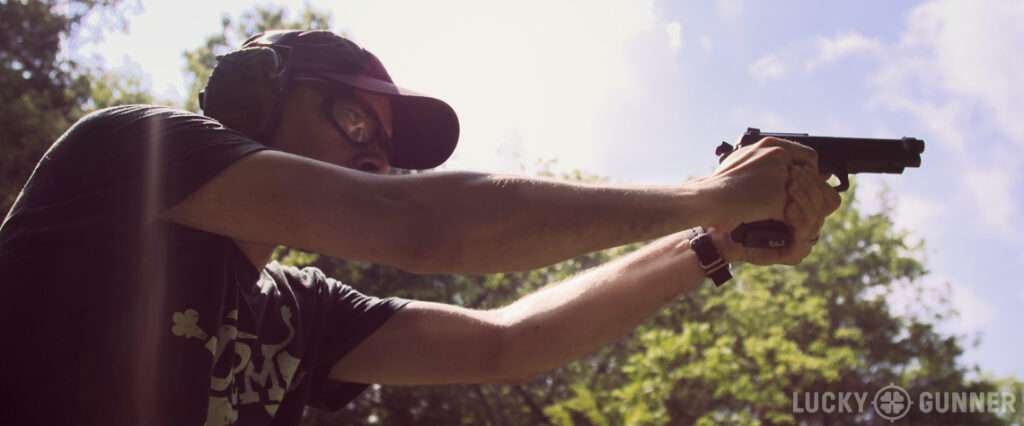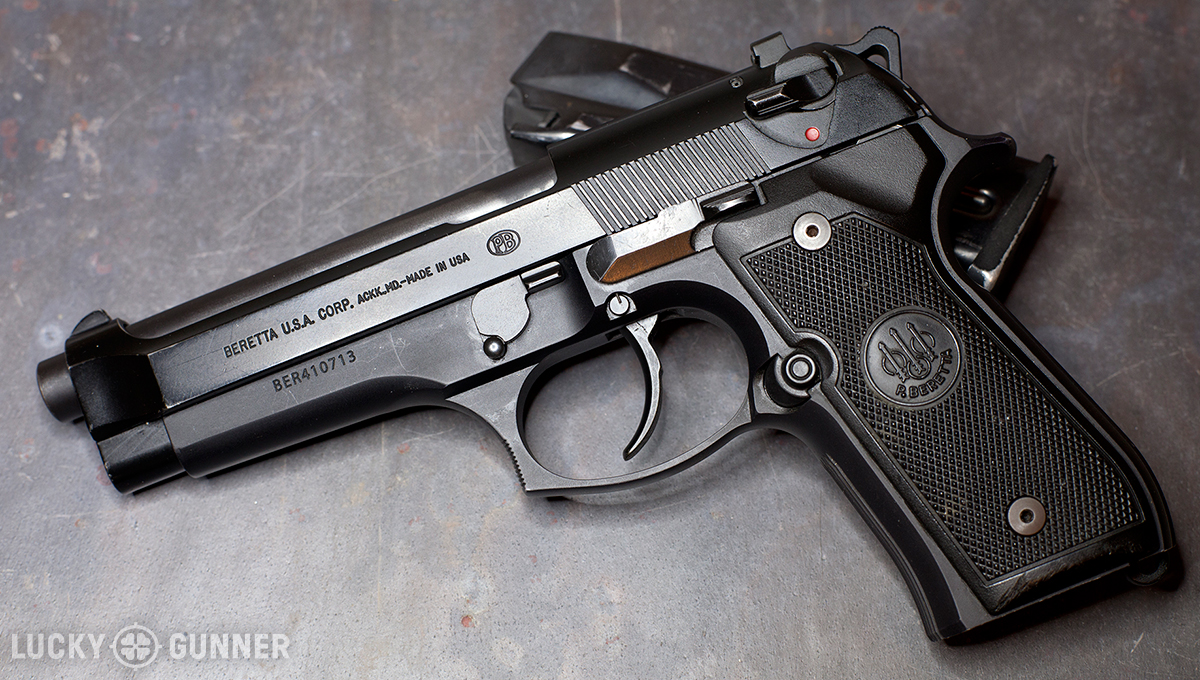In most violent encounters when a handgun is used in self-defense, the choice of handgun is not a significant factor in the outcome. Yep, you read that right. For all of the time and effort we spend on carefully selecting our tools for self-defense, the decision is not nearly as important in these scenarios as we’d like to think.
But that’s not to say it isn’t important at all. The gun we choose for self-defense has a huge impact on how we train, the techniques we learn, and the amount of enjoyment we get out of shooting (which, in turn tends to influence how often we practice). Our chosen firearm also plays a role in our vulnerability to accidents and other potential negative outcomes. After giving a lot of thought to these issues, I’ve recently decided to retire my much beloved striker-fired M&P pistols for serious self-defense use in favor of “old fashioned” hammer-fired double action pistols. I’ll be sharing more about the details of the specific guns I’m using in future videos. For now, here’s some more background on why I made the switch.
Why I Switched to Double Action Semi-Autos

Last week, I gave a quick background on traditional double action single action pistols and why they aren’t as popular as they used to be. Today I’m going to talk about why none of that matters because they are still awesome.
A lot of the younger shooters of Gun Culture 2.0 have been raised on Glocks, but I actually started out shooting double actions. I grew up in the 80s and 90s with Martin Riggs and John McClane and the Beretta 92 was the trademark of the modern action hero. The first handgun I ever fired was a Beretta 92FS. So when I went to buy my first gun, I bought a double action Beretta.
And I couldn’t shoot it at all. Like a lot of other people, I had a hard time with that double action trigger. So of course I sold it and bought… a different double action Beretta. And the next couple of pistols I bought after that were also double actions. I was kind of stubborn about it. All of this time I was gradually improving as a shooter, but I was still having a tough time with trigger control. So I went to a shooting class with a local instructor and asked him if he had any specific advice for shooting that double action trigger better. And his advice was to buy a 1911. I think he was only half serious, but he didn’t offer any other advice and he was pretty adamant that if you wanted to shoot to your full potential, you had to get a single action pistol.
Unfortunately, that experience is not unique. One of the biggest problems with mastering double action pistols is not so much that it’s really all that difficult, but there are just so many instructors out there who don’t know how to run these guns well and they give really bad advice.
Well, at the time, I couldn’t afford to start shooting .45 instead of 9mm, so I didn’t switch over to the 1911, but I did buy a striker fired pistol and I started practicing more regularly, and that’s when I started to see a lot of progress in my ability as a shooter.
So now several years down the road, it might seem strange that I have recently switched back to primarily shooting and carrying double action pistols. There’s a reason for it, and it goes back to the reason double action pistols were invented to begin with, and that is balancing shootability with safety. Traditional double action handguns offer more layers of safety compared to striker fired or single action pistols. I can’t really explain it any better than the late Todd Green, so I’m just going to quote a forum post of his from a few years back:
“[With] a trigger pull that is both longer and heavier than most other actions, there is far more tactile feedback that the trigger is being pulled in between the start of inadvertent unintentional movement and the Big Loud Noise. We’ve lost sight of this as a community with the prevalence of ever lighter and shorter striker fired action triggers and candidly I doubt we’ll see the pendulum swing back any time soon… The shooting community always blames the operator for every accident and never considers the role that equipment plays in making some guns more or less likely to facilitate those accidents.”
What that means is that if you mess up and get on the trigger too early — which happens a lot to people under stress — or if you think you need to shoot someone and then realize you don’t, the length of travel of the double action trigger gives you an extra split second to correct your course of action before you put a bullet somewhere it doesn’t belong.
Double action pistols are also safer when it comes to holstering the gun. This is probably the most dangerous thing we do with our handguns, and it’s when a lot of accidents happen. With a double action pistol, you can put your thumb on the hammer after you de-cock, and that way, it’s impossible for the gun to discharge if you accidentally leave your finger on the trigger or you get a strap or a piece of shirt caught in the trigger guard. And if you don’t remember to de-cock the gun or thumb the hammer, then you’re really just a pound or two of pressure away from where you’d be with a striker fired gun anyway.
But the advantages of traditional double action pistols aren’t just safety related. It’s also possible to reach a very high level of performance with these guns if you master the double action trigger. Once you get past that first shot, you’ve got a very short trigger reset and usually a really nice single action trigger that’s superior to just about any striker fired gun.
Now, I don’t want to ignore the shortcomings of double actions that I talked about last week. It’s going to take a little more effort and practice to learn how to run one of these guns really well compared to a pistol that has fewer controls and a trigger that’s consistent from one shot to the next. So it’s not for everybody, but I can give you four factors that led to my decision to switch to double actions.
First, I carry in the appendix inside the waistband position, so if I do make a mistake when I’m re-holstering, my femoral artery is right there, and… that could be really bad. I use a safe re-holstering technique that greatly mitigates that risk, but I like the extra layer of safety I get from being able to ride the hammer with my thumb while I’m re-holstering.
Second, I do a lot of shooting. I’m at the range at least once a week and that comes out to thousands of repetitions in and out of the holster and each one of those is an opportunity to make a potentially fatal mistake. Again, the most common accidents at the range are a lot less likely with a traditional double action pistol.
Third, watching other people shoot has relieved me of any delusion that anyone’s gun handling is always 100% safe. I’ve taken over 300 hours of firearms training from more than 30 different instructors. I know that even experienced and well-trained people can occasionally slip up because I’ve seen them do it. And if they’re capable of getting a little get sloppy on a shooting range, then I’m sure I can do it under the stress of a deadly force encounter. And really, I know I can get careless every now and then because I’ve seen myself do stuff on video I have no recollection of doing. Things like getting my finger on the trigger a just little too early when the gun comes out of the holster. Using a pistol with a double action trigger is not a substitute for trying to correct that behavior, but it’s a good redundancy to have, especially when you consider that we’re often not aware of the stuff we might be doing that is unsafe.
Finally, I have a really low tolerance for bad triggers. Most factory triggers in striker fired guns are pretty terrible. I can shoot these pistols, but not nearly as well as I would like and really, I don’t know many shooters who are performing at a high level who leave their striker fired pistols completely stock, either. It’s really common to try to improve these guns with different aftermarket parts or custom work to try to make them more shootable. But it’s really hard to do that without compromising the guns in some way that makes them more susceptible to an unintentional discharge.
With a DA/SA gun, even if I get a really nice custom trigger, I still have the safety of the long length of travel on that first double action shot. I spent most of last year shooting revolvers, so that DA trigger was a natural thing for me to transition to, and that’s a big part of why I chose double action guns rather than a single action or striker fired gun with a manual thumb safety.
So before you head to the comments section, I hope I’ve made it clear that I’m not saying that you have to carry a double action pistol in order to be safe. I will continue to recommend and test and review striker fired pistols and other types of handguns. I’m just saying that the average armed person probably has not given enough thought to just how easy it might be for their gun to go bang when they didn’t intend for it to. It would be pretty hypocritical for you to carry a gun for the unlikely event that you need it to save your life, but then turn around and refuse to give any critical thought to the safety of your chosen firearm because you believe that you can beat the odds and never make a mistake.



